Indigo: The story of India’s ‘blue gold’
For generations, family-run farms in South India have grown and produced the natural dye that was once colonial capital.
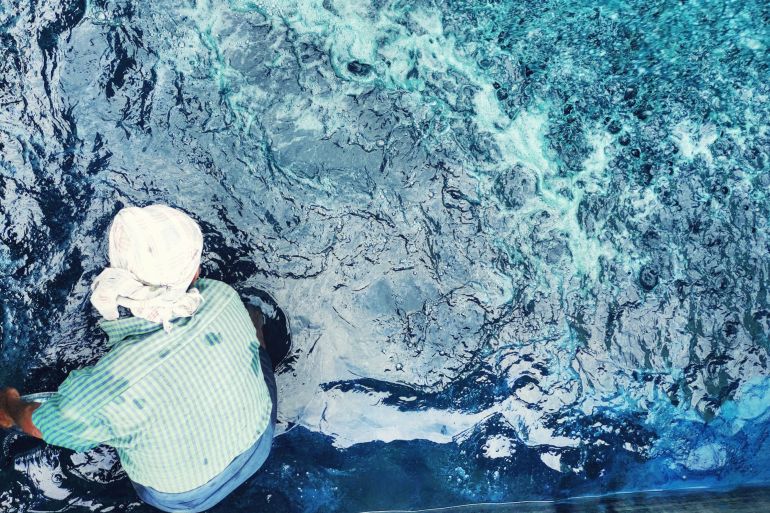
It is 6am in the small village of Kongarapattu in South India and the cloudy October sky is threatening to burst. In the factory, a foreman scuttles around anxiously, checking for absent labourers; two sari-clad neighbours whisper to one another while combing their long hair; and stray dogs run amok, sensing the anticipation in the air.
For four generations indigo has been grown, harvested and made into dye on this family-owned plot in Tamil Nadu.
Keep reading
list of 4 itemsThe army of women saving India’s storks
In India’s Assam, a young Muslim leader fights election to unite
Why India’s farmers promise to step up protests
Production, which usually takes place three times a year, was delayed this year because of the coronavirus pandemic. But October finally brought the first day of “thotti podurathu” – when the traditional tanks are set up to extract the dye from the Indigofera plants.
Before work can begin, labourers and onlookers gather around the century-old tanks for a simple pooja, or prayer, invoking divine blessings. The foreman says a two-minute prayer for Neel Atha (or the Blue Mother) – the sacred name the villagers have for indigo – and presents an offering of bananas and coconut, blessed fruits according to Hindu rituals.
“It is almost a festival for our village,” says Balachander Anbhazhagan. The 33-year-old is the scion of KMA Exports, an indigo farming and production company that has operated here since the 1960s.
Balachander’s great-grandfather started processing indigo during colonial times – when the naturally sourced dye was a valuable commodity.
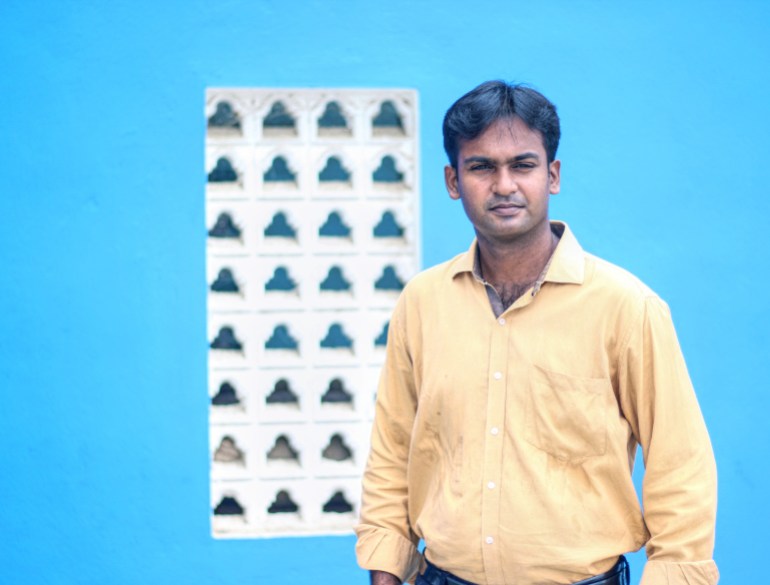
The Anbhazhagan family perfected the patient craft of extracting natural indigo dye from Indigofera plants, using the same century-old, colonial-era cement tanks their relatives used before them.
All these years later, the company is now the largest producer of natural indigo dye in India.
“Even as a child, I grew up with indigo all around me,” says the soft-spoken Balachander. “I have watched the indigo plants being harvested and have seen my grandmother offer her prayers to the Neel Atha before beginning indigo extraction at our plant.”
Here, indigo is perceived as a Blue Goddess. In fact, many Hindu Gods like Kaali and Krishna are often portrayed in the colour blue as it symbolises the colour of the cosmos.
“We envisage work as worship,” Balachander says.
Green leaves to blue dye
During colonial times, many Indian farmers were strong-armed by the British Raj into growing indigo instead of food crops, the dye was then bought by the Raj at unfairly low prices. Today, indigo is celebrated in Kongarappatu and neighbouring villages for putting them on the map, a far cry from its wretched colonial past. Every year, export companies, handicraft industries and renowned designers come knocking on the doors of this nondescript village to get their hands on the precious “blue gold”.
The work of getting dye from Indigofera happens in stages. First, the leaves are harvested from neighbouring farms; then they are gathered together and immersed in a huge tank filled with water, where they are weighed down and allowed to ferment. After the fermentation, the leaves are removed, and the water is drained into another massive tank where the solution oxidises and sediment settles at the bottom of the tank; finally, the sediment powder is dried and packed into cakes.
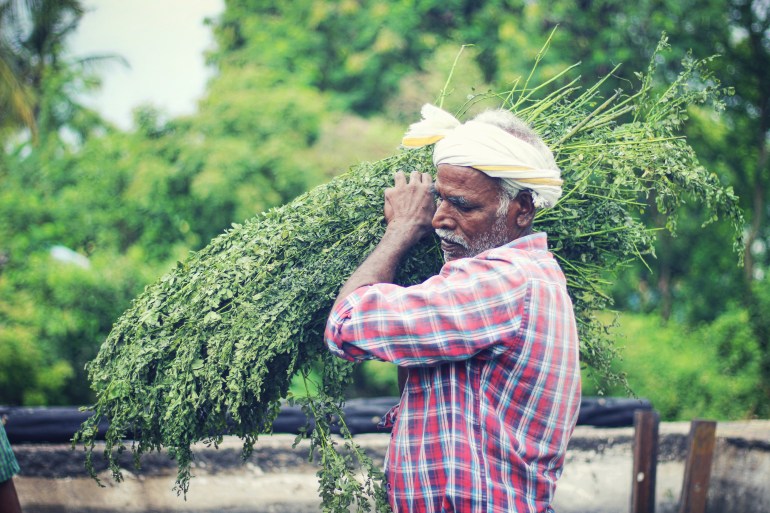
Indigofera plants, which look a bit like basil, must be harvested just before their pink flowers bloom. Then, the leaves have to reach the first tank within three hours in order to yield the best quality indigo, Balachander says.
A five-minute drive away from the extraction unit – past simple concrete village houses and a group of children playing cricket in a coconut grove – is an inconspicuous indigo farm where the leaves are ready for harvest. Out in the fields, the female farmers smile at the presence of strangers, while the men seem to acknowledge the visitors less.
In minutes, sickles swinging deftly, the men and women harvest the lush Indigofera plants that have grown about 10cm (four inches) high. They then bundle up their bounty of leaves, load it on a tractor and bring it to the tanks.
Back at the extraction unit, one of the tanks is already full from the previous day, wooden logs secured over the sea of leaves to keep the plants immersed in the water that shines with a greenish-blue hue.
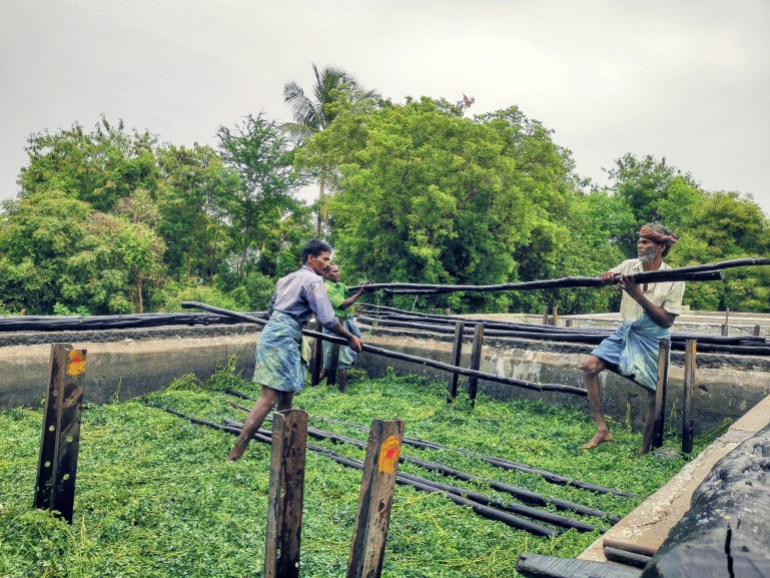
With the pooja complete, the foreman opens a hole in the upper tank and the water gushes into the tank below it. After that, to help the indigo particles settle as sediment at the bottom of the lower tank, the water has to be aerated, a process that used to be far more picturesque.
“Just [a] few years back, four labourers would stand in the tank and create turbulence in the water by kicking it for two hours,” says Balachander, explaining the old process of aeration. “Now, I had repurposed a machine used in aquaculture to mechanise this process.”
For 45 minutes, the pedalling machine moves the water around, kicking up a foamy layer. In an hour’s time, the greenish liquid turns into a brilliant blue. The top slot of the tank is then opened up, letting out water that will be used to irrigate nearby farms. After 21 hours of sedimentation, the bottom slot is opened to slowly release the remaining water in the tank, together with a leftover powder-like substance. This is then boiled in a brick kiln, filtered, and pressed and formed into small indigo cakes. The cakes are dried for five days before they are ready to be used as dye.
An ancient craft
With a twinkle in his eye, 48-year-old Pachaiyappan holds out his indigo-coloured palms, stained with the remains of another day spent turning Indigofera plants into blocks of dye.
For five months every year, for the last 20 years, the farm labourer has travelled from the outskirts of Kongrapattu to the Anbhazhagan’s estate to do this work.
“This colour will remain in my hand for a week,” he says, “but till date, this work has had no negative impact on my health as everything is natural.”
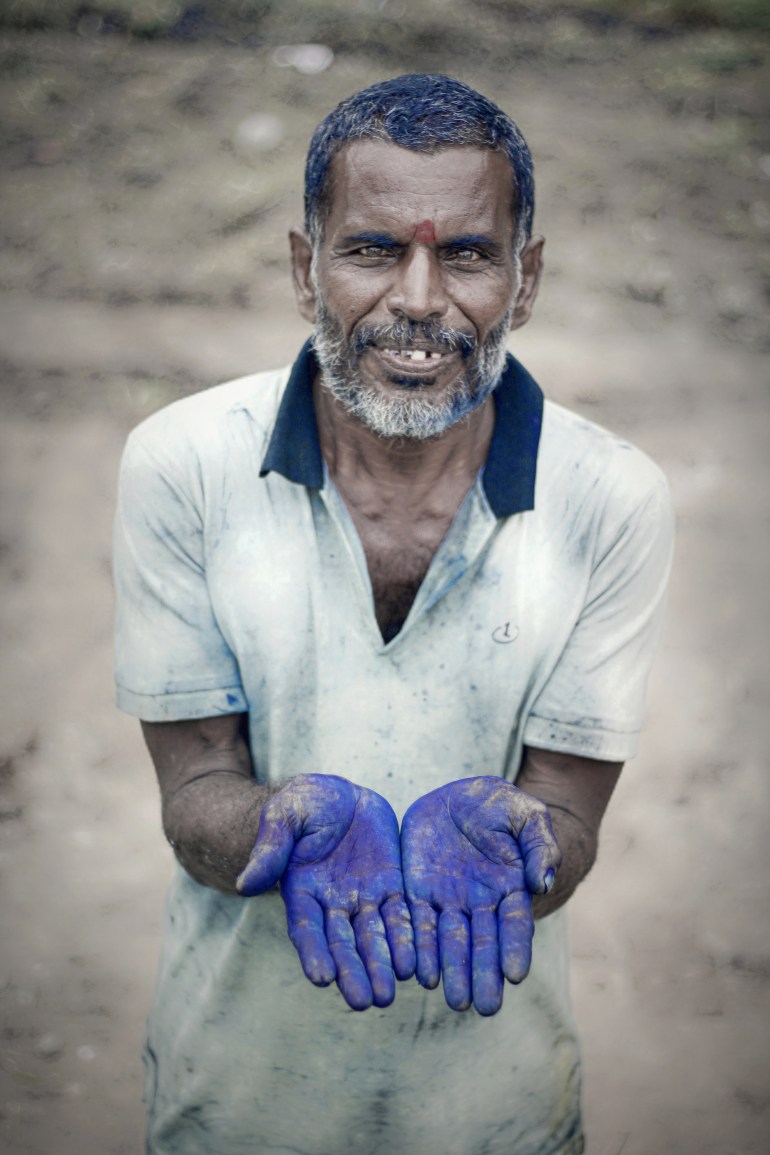
Pachaiyappan is so adept at the work that he can gauge when to stop the oxidation process by merely looking at the colour of the water. He is also known for pressing the boiled indigo sediment into perfectly-shaped cakes.
“As a child, I remember my father working in this very unit. With no motor then, he used to work on an etham – a traditional water irrigation device – to fill the tanks. He used to sing a song while walking up and down a 20-foot pole even as another helper filled the water in a pail, which was then used to fill the tanks. Now, things aren’t complicated. We don’t even have to beat the water any more (to oxidise it),” Pachaiyappan says.
Balachander says the manufacturing process has largely remained the same through the generations, with the exception of some improved mechanisation to ease things for the labourers. The most important thing for him is maintaining the original quality of the dye.
“We can’t afford even a speck of dirt in our indigo cakes,” he reminds his team as they go about their work.
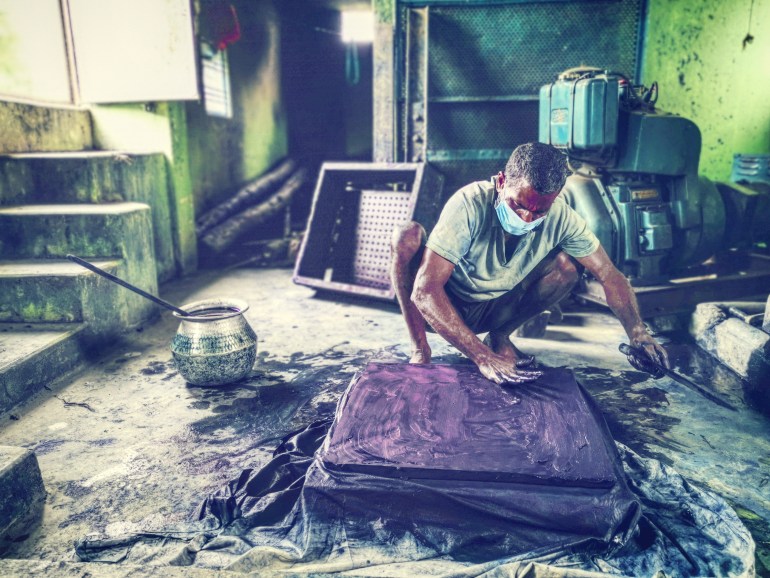
Balachander joined the family business in 2013. But it was not always part of his plan.
“I did not plan on taking up my father’s business,” he tells Al Jazeera. “But while pursuing my MBA in the United States, I had the opportunity of studying the supply chain management of our indigo production. The more I read about indigo’s history and learned of its eco-friendly nature, the more I was hooked.”
It came as a huge relief for his father, farmer-businessman M Anbhazhagan, 63, who was eager to pass on the secrets of the craft to the next generation.
Remembering the day he himself joined the business in 1982, Anbhazhagan says: “My father had received only 10 cents (4,356 square feet) of land from my grandfather for indigo farming and he had just two tanks for indigo production: an extraction tank where the harvested plants were seeped overnight and a sedimentation tank where the fermented water was oxidised manually by men (by kicking the greenish-blue water).”
Anbhazhagan looks through pictures of his parents smiling behind a younger version of him and tells us that it is their blessings that helped him grow an indigo empire in his small village.
When he took over the business, Anbhazhagan chose to sell directly to the artisans instead of selling it to agents. “This tripled our profits and by the early ‘90s, we expanded it to four tanks – two for extraction and two for sedimentation. Each tank could hold easily up to two tonnes of indigo plants and yields nearly 3–5kgs of indigo powder.”
While the family now owns about 30 acres (12 hectares) of land, they also have contracts with other indigo farmers in hundreds of villages across Tamil Nadu, allowing them to harvest more plants. It amounts to nearly 2,500 acres (1,011 hectares) in indigo production.
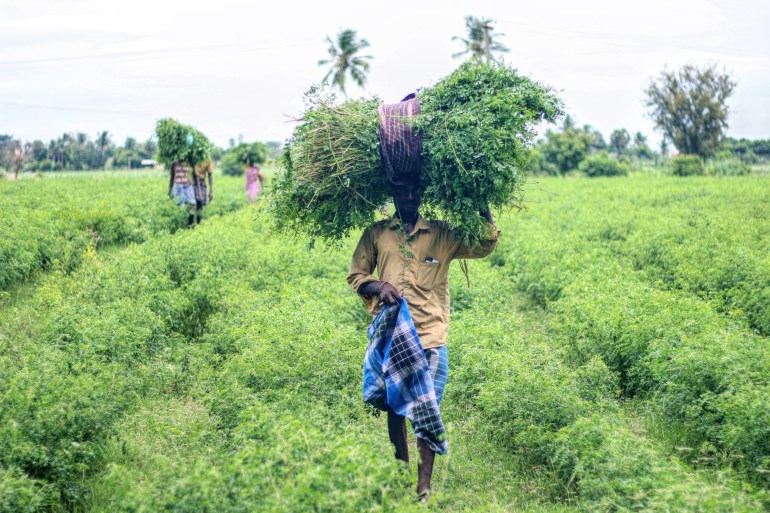
The family is also proud of the fact that the work is sustainable.
“The best thing about this process is it is zero waste as the spent indigo leaves from the first tank are taken back to the fields for composting and the water from the second tank is used for irrigation,” Balachander says. The older Anbhazhagan recalls that back in the day, the leftover indigo leaves were the only fertiliser his father used for his other crops like millets or paddy. “It works as a great nitrogen fixer for the soil,“ he explains.
Indigo has also helped the surrounding community. “Indigo is one of the main cash crops here and has helped farmers earn a decent living due to the thriving export dyeing business,” says Anbhazhagan. “I am happy that we have been able to provide work to at least 75 people in processing of indigo leaves.”
Where the blood is blue
Finding a skilled and obliging workforce is not easy for all indigo producers. Four kilometres (2.5 miles) away from Kongrapattu, farmer Mohammed Ayub, 39, is trying to revive his family’s legacy in indigo dye making in Vengandur, in the coastal Villupuram district. But he has encountered some roadblocks.
“Local women believe that Neel Amma (another local term of endearment for indigo that translates to Blue Mother) doesn’t like women working in the tanks,” he says. “With most men migrating out of our villages to find work in cities, it’s been very tough to find skilled labourers to make indigo dye.”
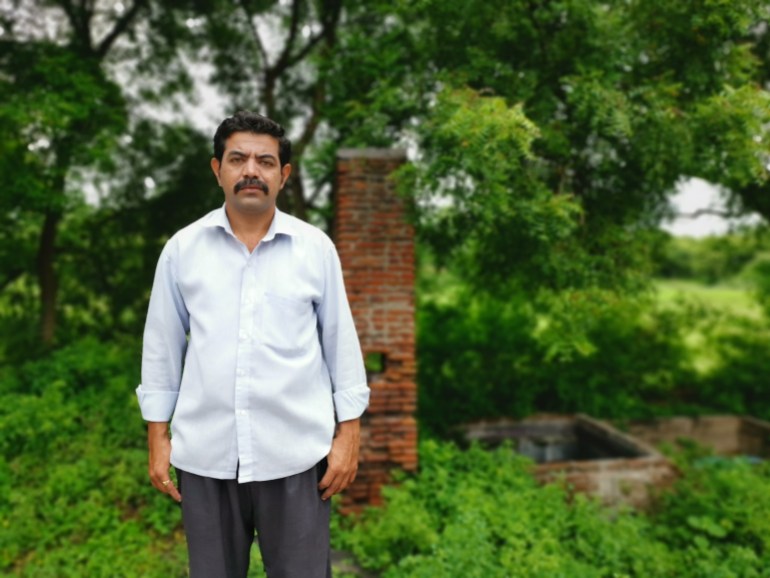
Ayub is a man of few words, and it takes a while for the farmer-producer to open up about his family’s journey with the mystical indigo. His great grandfather worked in the court of Tipu Sultan – an 18th-century ruler of Mysore from the neighbouring state of Karnataka, he says. After Tippu Sultan’s death in 1799, Ayub’s family relocated to Vellore district and then settled in Vengandur in the 1830s.
“As indigo was in high demand at that time, my great grandfather Janab Mohideen Basha took up the cultivation of Indigofera Tinctoria, a plant known to produce a good quality indigo dye.” In fact, records show that England alone imported 40,000 tonnes of Indigo from India in 1895.
The coronavirus also caused Ayub to temporarily shut down his indigo operations but he agrees to give a tour of the estate. Right in the middle of a busy highway, a large dilapidated wall welcomes us. Behind it are four huge tanks, largely overrun with wild shrubs and plants. Despite the vehicles whizzing by, there is hardly any human presence around. At a distance, a shepherd can be seen reigning in his bleating sheep.
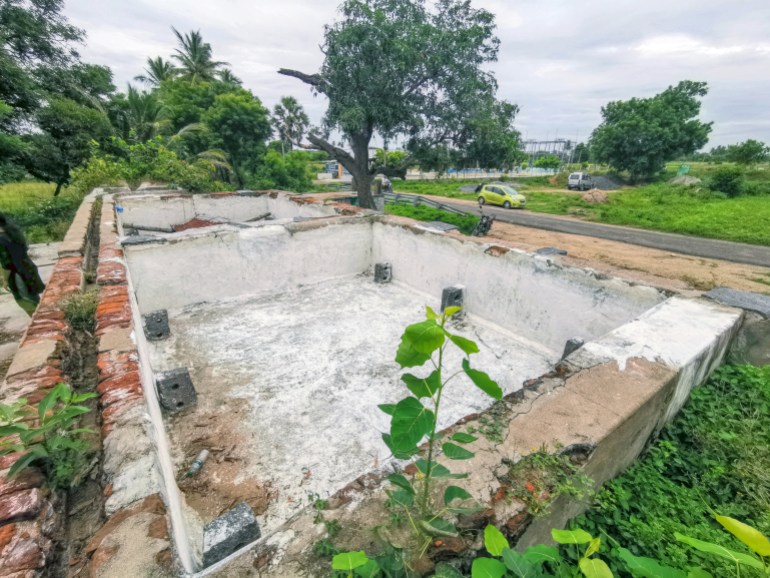
Ayub explains that he last ran the tank in January before the lockdowns commenced. For the visitor, it feels like being in a time capsule. The pleasant indigo fields guarded by tall coconut trees provide a perfect backdrop to the 15×15-foot (4.5×4.5-metre) indigo tanks.
For two centuries, these cascading tanks have magically transformed lush green indigo leaves into the deepest shades of blue dye. Behind it is a 12-foot-high (3.7-metre-high) colonial brick kiln (which is still used to boil the indigo mixture). A little further on the right, the gleaming water in a 36-foot-deep (11-metre-deep) ancient well that has stood for generations is a reminder of all that indigo has survived – from world wars to revolts, to chemical dyes, to the current coronavirus crisis.
Of colonial oppression and revolution
Indigo, also known as the King of Dyes, is one of the world’s most ancient dyes. It has been used by the people of Egypt and Asia for more than 4,000 years. Even a 12th-century Roman historian, Pliny the Elder, wrote about “indigo, a product of India, being a slime that adheres to the scum upon reeds. When it is sifted out it is black, but in dilution, it yields a marvellous mixture of purple and blue …”
Even until the 19th century, when synthetic indigo was discovered, the Indigofera plant was the only known source to achieve long-lasting blue. Though several countries in East Asia produced indigo, India remained a major source for the world. In the late 1500s, French and Norwegian officials even banned the Indian indigo, calling it the “devil’s dye”, to protect the production of their native woad-based blue dye. For the East India Company and later the British Raj, indigo turned out to be one of the most profitable commodities.
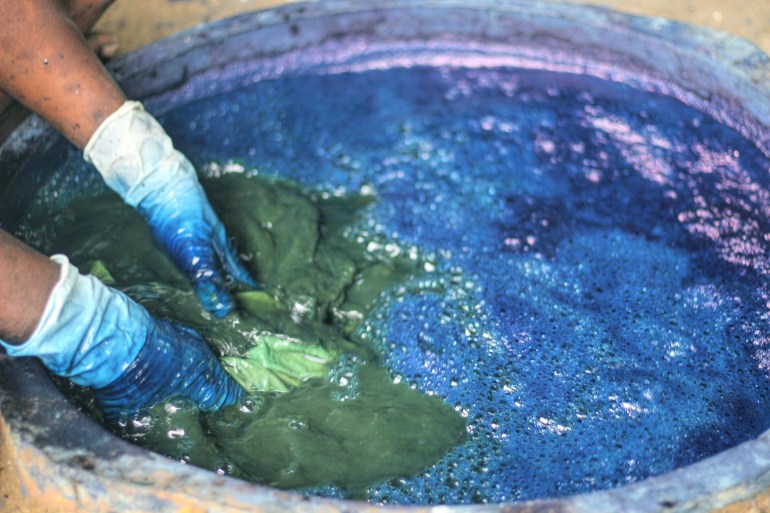
Tushar Gandhi, Mahatma Gandhi’s great-grandson, talks about how this “blue gold” led to one of the most defining moments of Indian independence.
“Indigo was a very precious dying source for textile-producing mills of England. When it was discovered that it grew well in certain North Indian states – like Bengal and Bihar – they utilised the zamindar (or landowner and landlord) system to force the cultivation of indigo instead of food crops,” he tells Al Jazeera via telephone.
In mid-19th century Bengal, these farmers were provided loans with such extremely high interest rates that it would pass on to the next generations, forcing descendants to become bonded indigo labourers. The selling price disparity was also so high that the farmers were only given 2.5 percent of what the indigo would fetch on a global market, he explains.
In 1859, the distraught Bengal farmers led a revolt that practically brought indigo production to its knees. Following the revolt, a commission was set to study the state of indigo peasants. The Indigo Commission report had then observed, “not a chest of Indigo reached England without being stained with human blood.”
“It was in Bengal’s first uprising against indigo dictatorship that farmers took oppressors to court and won a landmark judgement in their favour,” Tushar Gandhi says. “Years later, Bihar farmers reeled under the oppressive teenkathia system, where indigo had to be mandatorily grown in 3/20th of a farmland. With discovery of chemical dye by Germany (in 1878), the indigo market collapsed and the farmers’ situation in Bihar became even more deplorable.”
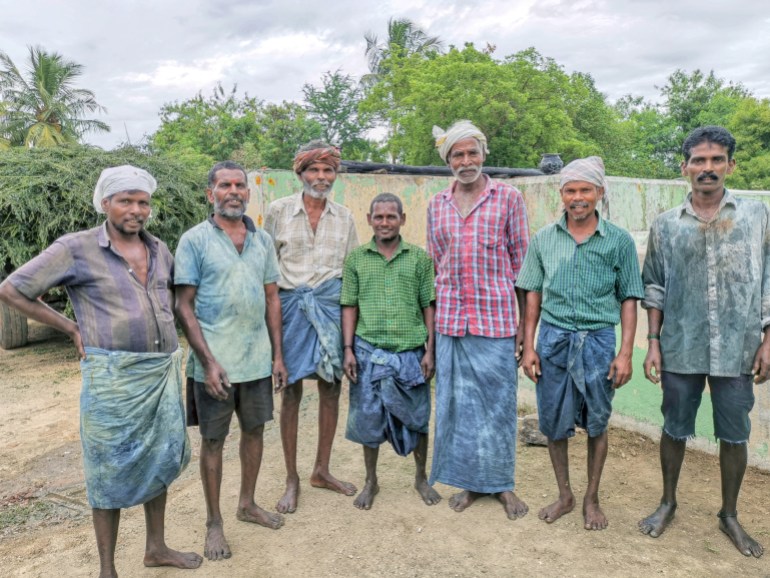
In 1917, when Mahatma Gandhi visited Champaran to meet and document the issues of the indigo farmers, it led to his first non-violent Satyagraha movement (march for truth).
“I believe Gandhi based his strategy on Bengal’s precedence to demand legal justice. At that time, the greatest oppression was against the agrarian community. There were agrarian revolts in many places and even though they were dispersed, they became a formidable force to deal with,” Tushar Gandhi adds. “Babu was shrewd enough to identify this segment and other impoverished craftsmen who were left unemployed by [the] industrial revolution; he used their unity to fight the battles for Indian Independence.”
Faithful farmers
While wars and revolts shook the indigo market, Ayub’s family has been faithfully growing indigo (together with other crops like sugarcane and groundnut) for four generations, since the 1830s.
“One reason could be indigo is a low-cost crop. There is no need for any external fertiliser and you can get a yield every three months,” Ayub suggests. But his uncle, Niyaz Ahamed, feels the crops are more about preserving their family’s legacy.
While Ayub had left his career in the hospitality industry to return to farming in his village in 2016, Ahamed had in fact relocated from the village to the capital city Chennai in 2000, to secure a better education for his children. Yet the mysterious blue refuses to let go of him, he says. “Even in a city like Chennai, while pursuing another business, we are trying to produce indigo dyes in plastic drums. It is a part of who we are,” says Ahamed, with a hint of pride in his voice.
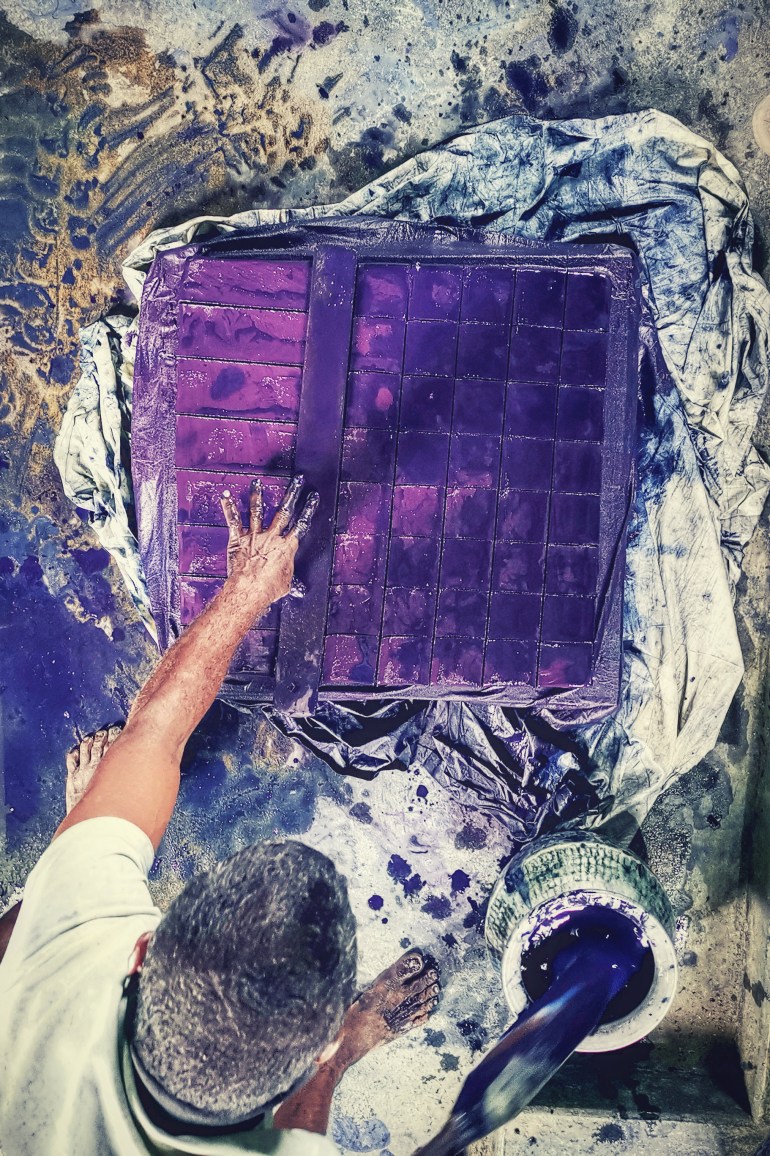
Although colonial indigo farming met much resistance in North India, Ahamed says that his father Dada Miyan Sahib (Ayub’s paternal grandfather) was always able to do business on his own terms – whether with British or French traders, or later with the Indian railways department.
“Even when we did not sow indigo, we would still rent out the tank for indigo production to private companies. My father’s only condition would be that they store the indigo dye in our house so that he can check and ensure the quality of the indigo before it is sold,” says Ahamed.
“I still remember my father sneaking out indigo dye to Pondicherry (a French colony at that time and whose border was closely monitored by the British Raj in India) and while coming back, he would bring us Chinese silk or a bottle of sugar mixed with water (to avoid detection).” If caught, he would have been arrested by the Raj.
As for Vengandur, indigo still plays an intrinsic role in the lives of people who live there.
“Whenever a child is born in our village, the cloth used for filtering the indigo dye is taken to swaddle the baby as it has medicinal properties. Older children with ailments like fever are also made to sleep on a piece of indigo-dyed cloth for faster recovery. We have also been regularly supplying indigo roots (avari in local parlance) to traditional healers who use it for various skin ailments and allergies. And of course, other farmers use our spent indigo sheaves as fertiliser for their fields,” says Ahamed.
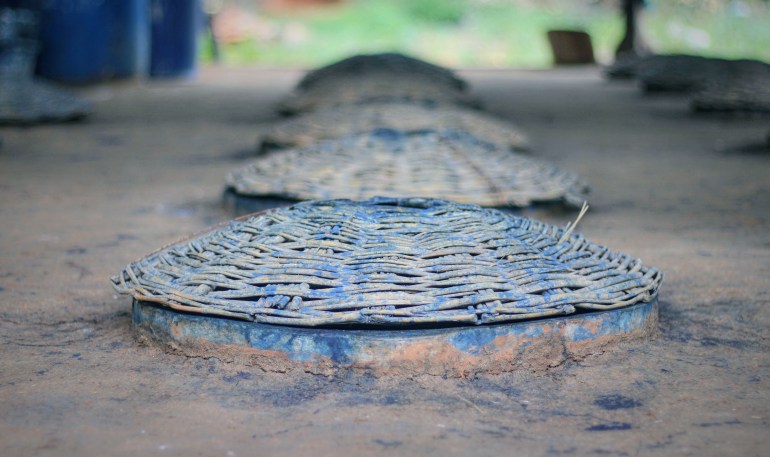
The art of natural dyeing
In Auroville, an hour’s drive from Kongarapattu, Jesus Ciriza Larraona is the founder of a natural dyeing research unit called The Colours of Nature. For more than 25 years, he has been perfecting the art of indigo dyeing, learning from ancient texts and traditional craftsmen from across India and the world.
At his premises, a group of masked women sit embroidering at a corner table, with their heads bowed in concentration. Meanwhile other men and women twist and twirl sections of cotton yarn as they wash them clean, two women dipping it in alum – a mordant used to set colours on fabric – while another dries a fresh batch of the yarn.
Larraona takes us to his sanctum sanctorum – a large shed where his indigo vats are kept. A pungent smell fills the air, amidst rows and rows of basket lids; interspersing those rows are indigo-dripping cloth filters which hang from the top of the shed like bats in a belfry.
“There are 60 pots, with 1,000 litre capacity each,” Larraona says as he removes a basket lid to reveal the vat below that is used to dye raw materials indigo.
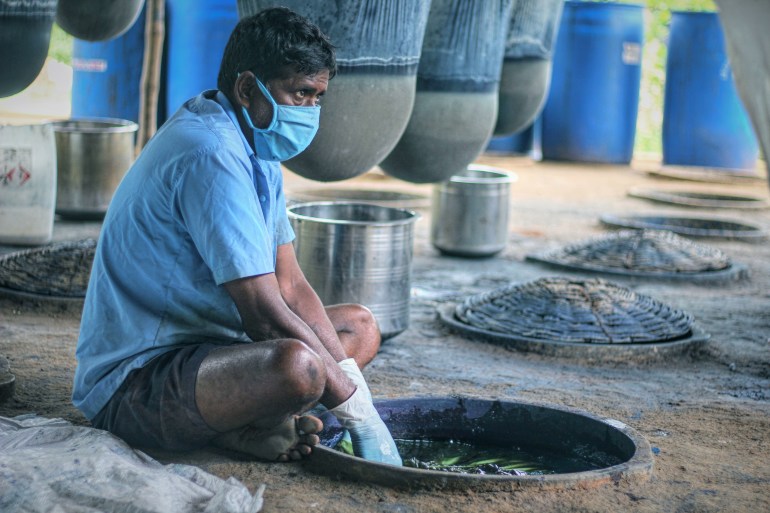
The indigo in the vat sports a greenish hue with a blue foam bubbling around it. Kumar, one of Larraona’s master craftsmen, slowly immerses the white yarn in the vat and rotates. After minutes of working, the yarn emerges as a dark shade of green. Another helper dries it out and in a matter of seconds, the green transforms into the magical indigo.
“The soluble indigo in the vat impregnates the white cloth. When taken out, it oxidises and becomes blue. The processing time varies based on the shade of indigo one needs,“ Larraona explains. He sources his indigo cakes from farmer-producer Anbhazhagan in Kongarappatu.
Larraona is originally from Spain. When asked how he ended up dyeing indigo in India, he laughs. “In 1992, I was on my second visit to India when a friend in Barcelona had requested me to source a carpet to play chess. So, I went to Srinagar to find out more about the beautiful Kashmiri carpets. The friendly locals had given me a shikara (houseboat) to discover the city on my own. It was while exploring the pristine lakes, I saw how the chemical dyeing of carpets was polluting the water bodies. It disturbed me,” he says.
As luck would have it, he stumbled upon a colony that worked with natural dyes while looking for artisans to make chess figurines. “So, when I decided to settle down in the international community of Auroville, I chose to work on the art of natural dyeing,” and thus The Colours of Nature was born in 1993. But the journey was not easy.
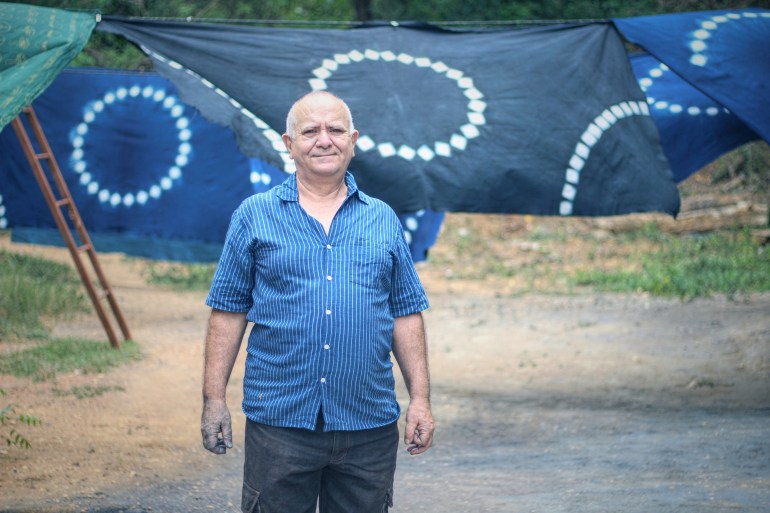
“I found an elaborative book on natural dyes from the 1890s and started to reproduce indigo. But it was not working. It was Mr Anbhazhagan who guided me to a Guledgudda in Karnataka, a village renowned for Ilkal saris (a traditional sari with cotton body and silk border). The Hasilcar family there had dyed indigo for generations. Two of the members agreed to come and teach me indigo dyeing in Auroville. We started with four pots, they knew all the techniques but the fermentation still wasn’t right. I then realised the Hasilcars had switched to synthetic indigo two decades ago hence couldn’t remember the smell of the dye and were not able to handle the pot.”
It was after interacting with various dyeing experts from Japan, Thailand and Mexico and reading several books, that he was able to understand and revive the natural indigo fermentation process. In fact, he held a workshop to teach it back to the Hasilcars.
He says that he continues to experiment to find more eco-friendly ways to dye and has not replaced the water in his vats for more than 24 years. He now has plans to reuse the sediment in the vat as a fixing agent for other colours too – including yellow (Marigold flower), and red (Rubia cordifolia).
The synthetic challenge
For all the efforts Larraona has taken to preserve and revive the art of natural dyeing, his toughest challenge has been dealing with synthetic colours that claim to be natural indigo in the market.
Jagadda Rajappa, an expert on natural dyeing and fabrics, agrees that it is very hard to find unadulterated indigo in the Indian market. “The cost of the German synthetic indigo (300–400 rupees per kilogramme – $4-5/kg) is much lesser than natural indigo (3,000 rupees/kg – $41/kg). The reduction process is the same and it is very difficult for a buyer to find out if the dye used is natural or not.”
Ayub shares an insider tip saying “natural indigo cakes normally float in water while chemical ones do not”.
While Balachander tells us export companies do run tests for authenticity, Rajappa opines that the Indian market is not as discerning towards natural dyes and hardly differentiates between the two. But the new breed of ‘green’ designers hopes to bring back the glory days of natural indigo in India.
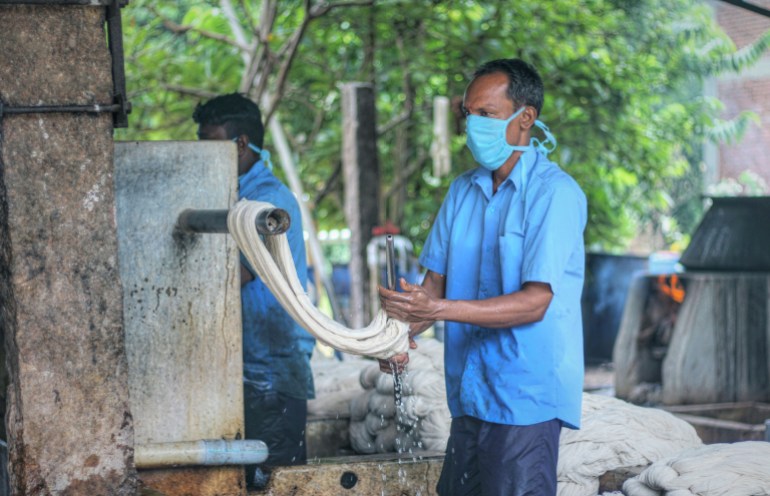
“You will always find a block of natural indigo in my office,” claims Delhi-based designer Rahul Mishra, who is known for eco-friendly ensembles that highlight handmade fabrics and natural dyes. He vaguely recalls his first experience with indigo.
“As a child, I remember seeing a huge building called Neel Kothi or blue house in my native village Malhausi (Neel Kothis were indigo factories of the British era). My grandmother revealed that almost everyone in the village grew indigo at some point of time. Inspired by Gandhiji, even my grandmother used to spin her own cotton and got it woven by a local weaver, before indigo dyeing it herself.”
Though Mahatma Gandhi fought against the indiscriminate practices of indigo planters, he lent his support to India’s native dyeing techniques and wrote a book on it (Vanaspatiyon Nu Rang). Hand-spun fabrics and natural dyes were seen as symbols of self-reliance during India’s independence movement. Currently, with the fashion industry turning to be the second major polluting industry in the world, Mishra believes that it is the right time to rediscover natural dyes like indigo to move towards a more sustainable future.
From the past, to the future
Thanks to the unrelenting efforts of experts like Larraona or Rajappa, the ancient art of indigo dyeing is not lost to the next generation. Rajappa’s own experimentation with natural dyes began with simple kitchen staples like turmeric and beets. After years of dabbling with natural dyes, she met her guru in Yellapa, who belonged to a family of traditional indigo dyers from Anantapur district in the state of Andhra Pradesh, 400km from Kongarappattu. It took her five years of coaxing to persuade the master craftsman to teach her his trade. When he agreed, she chose not to just to watch him work, she wanted to be drenched in the deep indigo rituals.
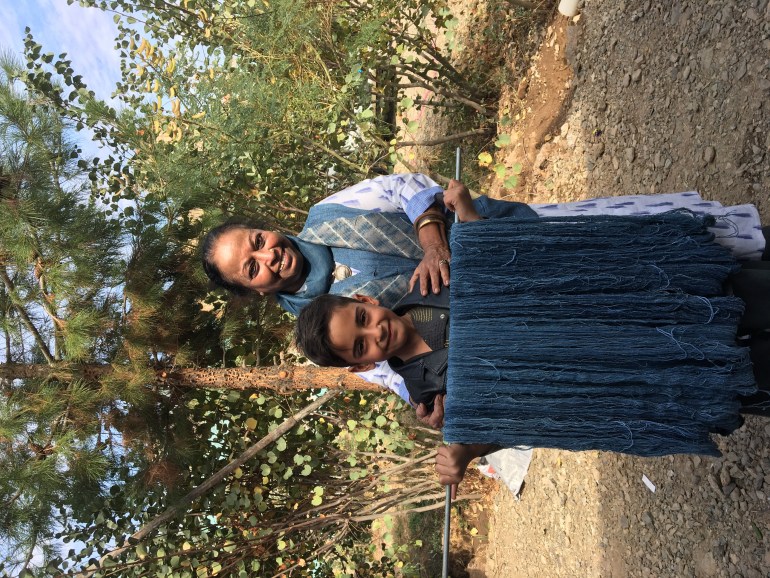
Yellapa had about 100 vats and Rajappa went about learning every nuance – from burying the pots in packed earth to stabilise the temperature, to feeding the vat with cassia tora seeds to speed up the fermentation process, to refilling the indigo dyes.
“We need to treat the vat like a living organism, it would take all of our senses to know when it is perfect. From smell, touch to even stirring sound, one can perfect the art of indigo dyeing only with time. Even if a vat goes wrong, an artisan would know ways to fix it. With patience, you will be able to watch a vat transform nothingness into abundance,” she says. And that experience is precisely what she wants to share with anyone willing to give in to the spirit of Indigo.
Having conducted various natural dyeing workshops, Rajappa says it is heartening to see the revival of indigo farming and dyeing in various pockets of India – from Puducherry to Vijayawada, Rajasthan to Bengal.
She believes it is the right time to relook at the indigenous knowledge of natural dyeing and use local ingredients to create sustainable dyes.
“Nature will never tire of surprising us with her colours,“ she says.